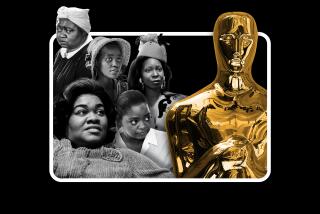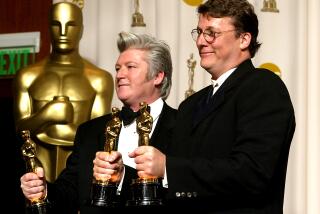The Envelope: Colleen Atwood doubles odds with ‘Big Eyes,’ ‘Into the Woods’
It turns out not many costume designers have been nominated for an Oscar for a pair of films in the same year, but Colleen Atwood just might do that very thing. The 10-time nominee and three-time Oscar winner has two films in consideration this season: Tim Burton’s bio-drama “Big Eyes,” about kitschy painter Margaret Keane, and the fairy-tale musical “Into the Woods,” based on Stephen Sondheim’s beloved Broadway hit. “They’ve each been made by really great directors, and that makes my job easy. OK, easier,” Atwood says.
What was the design challenge for “Big Eyes”?
Separating all the different worlds that the story went through — from the small Midwestern town feel in the beginning to the explosion of the ‘60s in San Francisco, to Los Angeles, Hawaii, etc. — and still try to keep Margaret [played by Amy Adams] as real as we could based on the research we had. Amy Adams is an amazingly subtle actress, so her clothes shouldn’t scream, “I’m from 1961.” The time period should blend away in a period film and you see the people inside it, making it look as a whole.
Which is the opposite of “Into the Woods.” What was the overall challenge there?
I wanted to marry and unify the overall look of the film, and it came about as I was looking at the trees and I was mesmerized by the wood and the beautiful leaf shapes, so I used that [wood theme] to create textiles for the film.
For example, Jack’s trousers had that vertical twig thing going on.
Yes, and Meryl’s [Streep, who plays the Witch] costume had a slight leather cording and satin sewn onto a chiffon background that gave it a wood-like texture, and it could twist and still be lightweight. We used ribbons for the second one with the poufy sleeves.
How involved is director Rob Marshall in the costumes?
He’s very concerned about the costumes serving the physical needs of the actors. Since he comes from a big dance background, he has a really good eye for how something’s going to move and how something is going to look moving in an environment. Visually, he’s very strong and reactive, and I show him everything before I make it. He definitely understands it all.
I understand Johnny Depp came up with the idea of using a zoot suit for his Big Bad Wolf costume, true?
We were talking about the Wolf, and I was going more with a lifelike wolf-shaped body and with a longer tail, and he said, “Oh, let’s do a zoot suit.” And also the music was an inspiration because it had a kind of jazzy thing to it. So we went with a zoot but a more animated zoot from the cartoons. I collaborated with an embroiderer who figured out how to make the “fur” collar and tail from thread. They used to make wigs like this in the ‘20s, and I’ve always been fascinated by it and wanted to use it some way, and so this was a very good opportunity.
How involved was Meryl Streep with her costumes?
Meryl is a very prepared actress;, she definitely gave me lots of fittings. We worked on the costumes to make sure they could do what she needed them to do. And we collaborated with Roy [J. Roy Helland], her longtime hair and makeup artist, and we came up with the idea of having the dress and the wig be the same tonality [of blue]. It was an exciting thing when we tried that wig on — that’s one of those moments, and not to mention you’re not just trying it on anyone, you’re trying it on the Meryl Streep.
What about some of the other fairy-tale costumes?
For Little Red Riding Hood, I messed around with a lot of stuff, and I ended up with the right color red in this very thin lambskin suede, because the velvet was a little clunky, silk was kind of too light. The lining was a really red taffeta.
Rapunzel’s was a thin, washed silk taffeta in a very pale pink with a layer of pale green over it, which gave it a glow. I was playing around with a bondage theme, so I came up with the idea of using satin ties wrapped around her middle and arms. It had a ghostly, glowing quality.
The princes were very different characters. Rapunzel’s prince was a nod to the classical rebel bad boy, and then Cinderella’s Prince Charming had to be every girl’s prince, the fairy-tale prince.
Cinderella’s stepmother and stepsisters were quite a group. I chose black with taupe because I wanted a positive-negative design and I didn’t want it to be black and white. I tried brighter colors, but we decided to go with the more muted, dark colors.
The Baker and his wife had more folk costumes, more traditional Brothers Grimm, a slight vibe toward that German look. Her top was made of tiny pieces of velvet and printed silk sewn together with cording going through it, to again have that bark quality.
More to Read
From the Oscars to the Emmys.
Get the Envelope newsletter for exclusive awards season coverage, behind-the-scenes stories from the Envelope podcast and columnist Glenn Whipp’s must-read analysis.
You may occasionally receive promotional content from the Los Angeles Times.






